Pilot Study on Resuscitation Volume’s Effect on Perfusion and Inflammatory Cytokine Expression in Peri-Burn Skin: Implications for Burn Conversion
Abstract
1. Introduction
2. Materials and Methods
2.1. Animal Burn Wound Model
2.2. Laser Doppler Imaging
2.3. Gene Expression Analysis
2.4. Terminal Deoxynucleotidyl-Transferase-Mediated Dutp Nick End Labeling (TUNEL) Staining
2.5. Statistics
3. Results
3.1. Fluid Rates and Urine Outputs Were Different Among Resuscitation Groups
3.2. Resuscitation Levels Affect Perfusion in Peri-Burn Skin
3.3. Resuscitation Levels Affect Cytokine Expression in Peri-Burn Skin
3.4. Resuscitation Levels Affect Expression of TUNEL
4. Discussion
5. Conclusions
Author Contributions
Funding
Institutional Review Board Statement
Data Availability Statement
Conflicts of Interest
Abbreviations
| TBSA | Total body surface area |
| LDI | Laser Doppler Imaging |
| RNA | Ribonucleic acid |
| qRT-PCR | Quantitative reverse transcription–polymerase chain reaction |
| IL-6 | Interleukin 6 |
| CXCL8 | Chemokine (C-X-C motif) ligand 8 |
| IFN-γ | Interferon-gamma |
| TUNEL | Terminal deoxynucleotidyl-transferase-mediated dUTP nick-end labeling |
| BWP | Burn wound progression |
| IV | Intravenous |
| LR | Lactated ringer |
| UO | Urine output |
| ROS | Reactive oxygen species |
| AAALAC | Association for Assessment and Accreditation of Laboratory Animal Care International |
| PHS | Public Health Service |
| IACUC | Institutional Animal Care and Use Committee |
| AR | Adequate resuscitation |
| UR | Under-resuscitation |
| OR | Over-resuscitation |
| ANOVA | Analysis of variance |
| rTDT | Recombinant terminal deoxynucleotidyl transferase |
| DAPI | 4′,6-Diamidino-2-phenylindole |
| DI | H2O de-ionized water |
| SCC | Saline-sodium citrate |
| GFP | Green fluorescent protein |
| ARDS | Acute respiratory distress syndrome |
| TNF-α | Tumor necrosis factor-alpha |
References
- Schaefer, T.J.; Tannan, S.C. Thermal Burns. In Environmental Emergencies and Injuries in Nature; Nova Medicine and Health: Hauppauge, NY, USA, 2023; pp. 41–47. [Google Scholar] [CrossRef]
- Jeschke, M.G.; van Baar, M.E.; Choudhry, M.A.; Chung, K.K.; Gibran, N.S.; Logsetty, S. Burn injury. Nat. Rev. Dis. Primers 2020, 6, 11. [Google Scholar] [CrossRef]
- Cartotto, R.; Burmeister, D.M.; Kubasiak, J. C. Burn Shock and Resuscitation: Review and State of the Science. J. Burn Care Res. 2022, 43, 567–585. [Google Scholar] [CrossRef]
- Cancio, L.C. Initial assessment and fluid resuscitation of burn patients. Surg. Clin. N. Am. 2014, 94, 741–754. [Google Scholar] [CrossRef]
- Paratz, J.D.; Stockton, K.; Paratz, E.D.; Blot, S.; Muller, M.; Lipman, J.; Boots, R.J. Burn resuscitation--hourly urine output versus alternative endpoints: A systematic review. Shock 2014, 42, 295–306. [Google Scholar] [CrossRef]
- Pham, T.N.; Cancio, L.C.; Gibran, N.S. American Burn Association practice guidelines burn shock resuscitation. J. Burn Care Res. 2008, 29, 257–266. [Google Scholar] [CrossRef] [PubMed]
- Alvarado, R.; Chung, K.K.; Cancio, L.C.; Wolf, S.E. Burn resuscitation. Burns 2009, 35, 4–14. [Google Scholar] [CrossRef] [PubMed]
- Peeters, Y.; Lebeer, M.; Wise, R.; Malbrain, M.L.N.G. An overview on fluid resuscitation and resuscitation endpoints in burns: Past, present and future. Part 2—Avoiding complications by using the right endpoints with a new personalized protocolized approach. Anaesthesiol. Intensive Ther. 2015, 47, s15–s26. [Google Scholar] [CrossRef] [PubMed]
- Saffle, J.R. Fluid Creep and Over-resuscitation. Crit. Care Clin. 2016, 32, 587–598. [Google Scholar] [CrossRef]
- Smith, R.D.; Carney, B.C.; Garg, G.; Monger, K.W.; Prindeze, N.J.; Shupp, J.W.; Moffatt, L.T. Modeling Burn Progression Using Comb Burns: The Impact of Thermal Contact Duration on Model Outcomes. J. Surg. Res. 2021, 260, 155–162. [Google Scholar] [CrossRef]
- Lu, M.; Zhao, J.; Wang, X.; Zhang, J.; Shan, F.; Jiang, D. Research advances in prevention and treatment of burn wound deepening in early stage. Front. Surg. 2022, 9, 1015411. [Google Scholar] [CrossRef]
- Jay, J.W.; Duggan, R.P.; Branski, L.K.; Wolf, S.E.; Ansari, N.; El Ayadi, A. Therapeutic Strategies to Reduce Burn Wound Conversion. Medicina 2022, 58, 922. [Google Scholar] [CrossRef]
- Asuku, M.; Shupp, J.W. Burn wound conversion: Clinical implications for the treatment of severe burns. J. Wound Care 2023, 32, S11–S20. [Google Scholar] [CrossRef]
- Arabidarrehdor, G.; Kao, Y.-M.; Hahn, J.-O.; Burmeister, D.; Parajuli, B.; Carney, B.; Keyloun, J.; Moffatt, L.; Shupp, J.; Reese, A.; et al. 103 Analysis of Arterial Blood Pressure Waveform Features in a Porcine Model of Burn and Resuscitation. J. Burn Care Res. 2023, 44 (Suppl. 2), S60. [Google Scholar] [CrossRef]
- Arabidarrehdor, G.; Kao, Y.-M.; Oliver, M.A.; Parajuli, B.; Carney, B.C.; Keyloun, J.W.; Moffatt, L.T.; Shupp, J.W.; Hahn, J.-O.; Burmeister, D.M. The Potential of Arterial Pulse Wave Analysis in Burn Resuscitation: A Pilot in Vivo Study. J. Burn Care Res. 2023, 44, 599–609. [Google Scholar] [CrossRef]
- Carney, B.C.; Moffatt, L.T.; Travis, T.E.; Nisar, S.; Keyloun, J.W.; Prindeze, N.J.; Oliver, M.A.; Kirkpatrick, L.D.; Shupp, J.W. A Pilot Study of Negative Pressure Therapy with Autologous Skin Cell Suspensions in a Porcine Model. J. Surg. Res. 2021, 267, 182–196. [Google Scholar] [CrossRef]
- Shen, C.; Wei, D.; Wang, G.; Kang, Y.; Yang, F.; Xu, Q.; Xia, L.; Liu, J.; Raboisson, D. Swine hemorrhagic shock model and pathophysiological changes in a desert dry-heat environment. PLoS ONE 2021, 16, e0244727. [Google Scholar] [CrossRef] [PubMed]
- Simovic, M.O.; Bynum, J.; Liu, B.; Lucca, J.J.D.; Li, Y. Impact of Immunopathy and Coagulopathy on Multi-Organ Failure and Mortality in a Lethal Porcine Model of Controlled and Uncontrolled Hemorrhage. Int. J. Mol. Sci. 2024, 25, 2500. [Google Scholar] [CrossRef] [PubMed]
- Mandal, A. Burn wound depth assessment—Is laser Doppler imaging the best measurement tool available? Int. Wound J. 2006, 3, 138. [Google Scholar] [CrossRef]
- Liu, A.; Ocotl, E.; Karim, A.; Wolf, J.J.; Cox, B.L.; Eliceiri, K.W.; Gibson, A.L. Modeling early thermal injury using an ex vivo human skin model of contact burns. Burns 2021, 47, 611–620. [Google Scholar] [CrossRef] [PubMed]
- Keyloun, J.W.; Campbell, R.; Carney, B.C.; Yang, R.; Miller, S.-A.; Detwiler, L.; Gautam, A.; Moffatt, L.T.; Hammamieh, R.; Jett, M.; et al. Early Transcriptomic Response to Burn Injury: Severe Burns Are Associated With Immune Pathway Shutdown. J. Burn Care Res. 2022, 43, 306–314. [Google Scholar] [CrossRef]
- Chaudhry, H.; Zhou, J.; Zhong, Y.; Ali, M.M.; McGuire, F.; Nagarkatti, P.S.; Nagarkatti, M. Role of Cytokines as a Double-Edged Sword in Sepsis. In Vivo 2013, 27, 669. Available online: https://pmc.ncbi.nlm.nih.gov/articles/PMC4378830 (accessed on 20 February 2025). [PubMed]
- Korkmaz, H.I.; Flokstra, G.; Waasdorp, M.; Pijpe, A.; Papendorp, S.G.; de Jong, E.; Rustemeyer, T.; Gibbs, S.; van Zuijlen, P.P.M. The Complexity of the Post-Burn Immune Response: An Overview of the Associated Local and Systemic Complications. Cells 2023, 12, 345. [Google Scholar] [CrossRef]
- Burgess, M.; Valdera, F.; Varon, D.; Kankuri, E.; Nuutila, K. The Immune and Regenerative Response to Burn Injury. Cells 2022, 11, 3073. [Google Scholar] [CrossRef]
- Shen, H.; Yao, P.; Lee, E.; Greenhalgh, D.; Soulika, A.M. Interferon-gamma inhibits healing post scald burn injury. Wound Repair Regen 2012, 20, 580–591. [Google Scholar] [CrossRef]
- Chi, Y.; Liu, X.; Chai, J.A. A narrative review of changes in microvascular permeability after burn. Ann. Transl. Med. 2021, 9, 719. [Google Scholar] [CrossRef]
- De Oliveira, S.; Rosowski, E.E.; Huttenlocher, A. Neutrophil migration in infection and wound repair: Going forward in reverse. Nat. Rev. Immunol. 2016, 16, 378. [Google Scholar] [CrossRef] [PubMed]
- Roman, J.; Rangasamy, T.; Guo, J.; Sugunan, S.; Meednu, N.; Packirisamy, G.; Shimoda, L.A.; Golding, A.; Semenza, G.; Georas, S.N. T-Cell Activation under Hypoxic Conditions Enhances IFN-γ Secretion. Am. J. Respir. Cell Mol. Biol. 2009, 42, 123. [Google Scholar] [CrossRef]
- Ladiwala, U.; Bankapur, A.; Thakur, B.; Santhosh, C.; Mathur, D. Raman Spectroscopic Detection of Rapid, Reversible, Early-Stage Inflammatory Cytokine-Induced Apoptosis of Adult Hippocampal Progenitors/Stem Cells. January 2014. Available online: https://arxiv.org/pdf/1401.7497 (accessed on 26 June 2025).
- Sarkar, S.A.; Kutlu, B.; Velmurugan, K.; Kizaka-Kondoh, S.; Lee, C.E.; Wong, R.; Valentine, A.; Davidson, H.W.; Hutton, J.C.; Pugazhenthi, S. Cytokine-mediated induction of anti-apoptotic genes that are linked to nuclear factor kappa-B (NF-κB) signalling in human islets and in a mouse beta cell line. Diabetologia 2009, 52, 1092–1101. [Google Scholar] [CrossRef][Green Version]
- Leon-Villapalos, J.; Barret, J.P. Surgical Repair of the Acute Burn Wound: Who, When, What Techniques? What Is the Future? J. Burn Care Res. 2023, 44 (Suppl. 1), S5–S12. [Google Scholar] [CrossRef] [PubMed]
- Dolgachev, V.A.; Ciotti, S.; Liechty, E.; Levi, B.; Wang, S.C.; Baker, J.R.; Hemmila, M.R. Dermal Nanoemulsion Treatment Reduces Burn Wound Conversion and Improves Skin Healing in a Porcine Model of Thermal Burn Injury. J. Burn Care Res. 2021, 42, 1232. [Google Scholar] [CrossRef] [PubMed]
- Deveci, M.; Eski, M.; Sengezer, M.; Kisa, U. Effects of cerium nitrate bathing and prompt burn wound excision on IL-6 and TNF-α levels in burned rats. Burns 2000, 26, 41–45. [Google Scholar] [CrossRef] [PubMed]
- Pape, S.A.; Baker, R.; Wilson, D.; Hoeksema, H.; Jeng, J.; Spence, R.J.; Monstrey, S. Burn wound healing time assessed by laser Doppler imaging (LDI). Part 1: Derivation of a dedicated colour code for image interpretation. Burns 2012, 38, 187–194. [Google Scholar] [CrossRef] [PubMed]
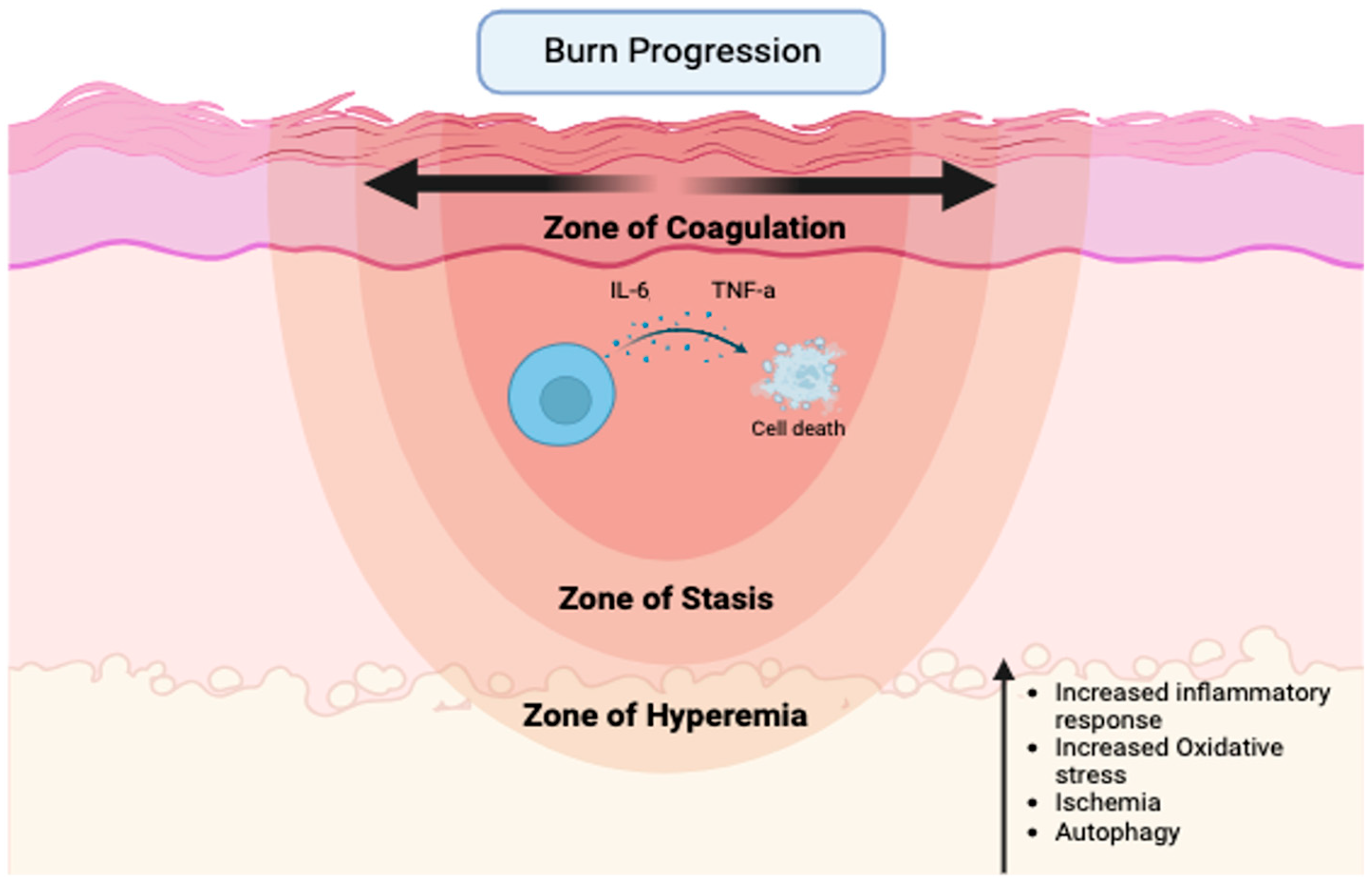
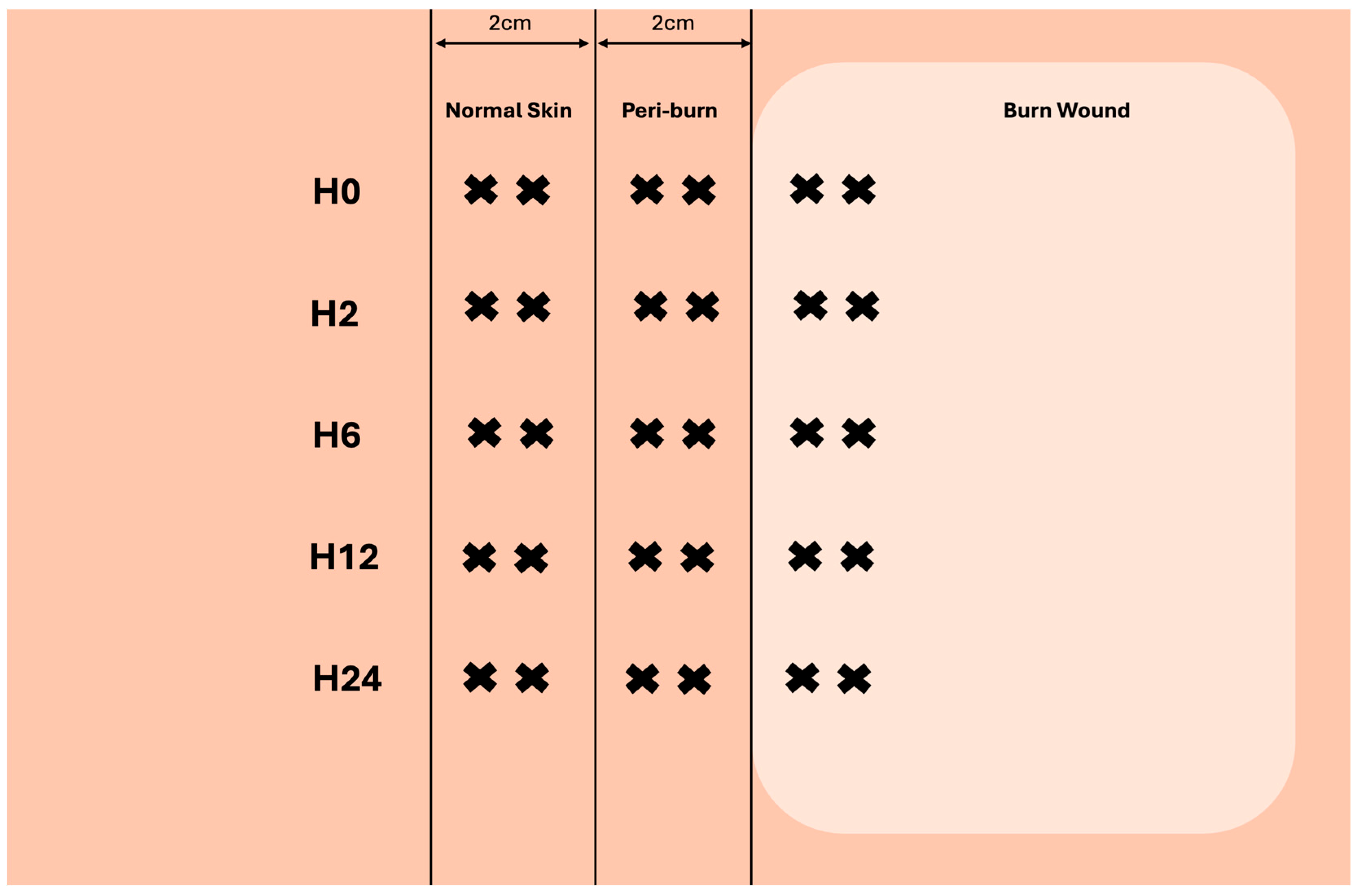
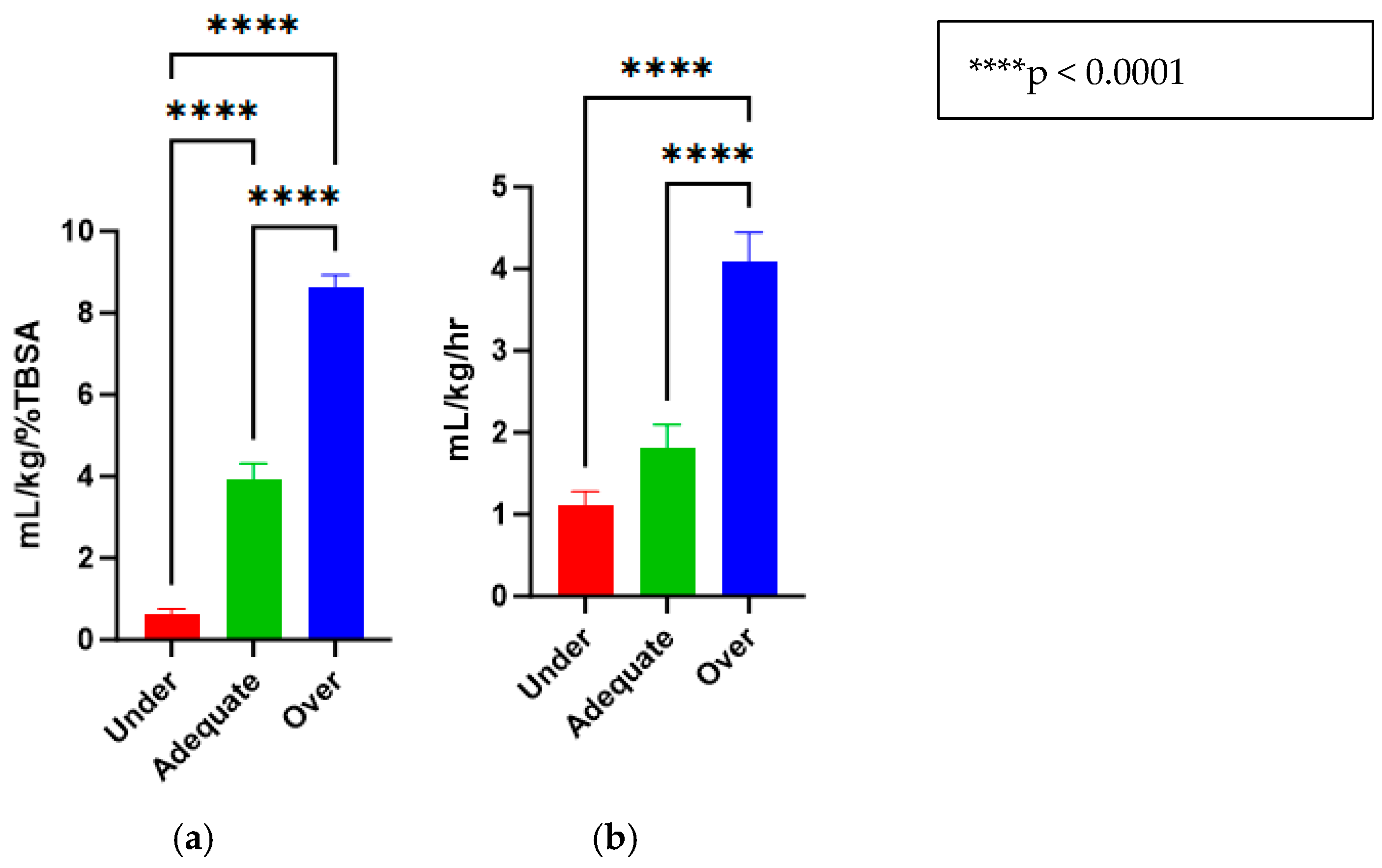
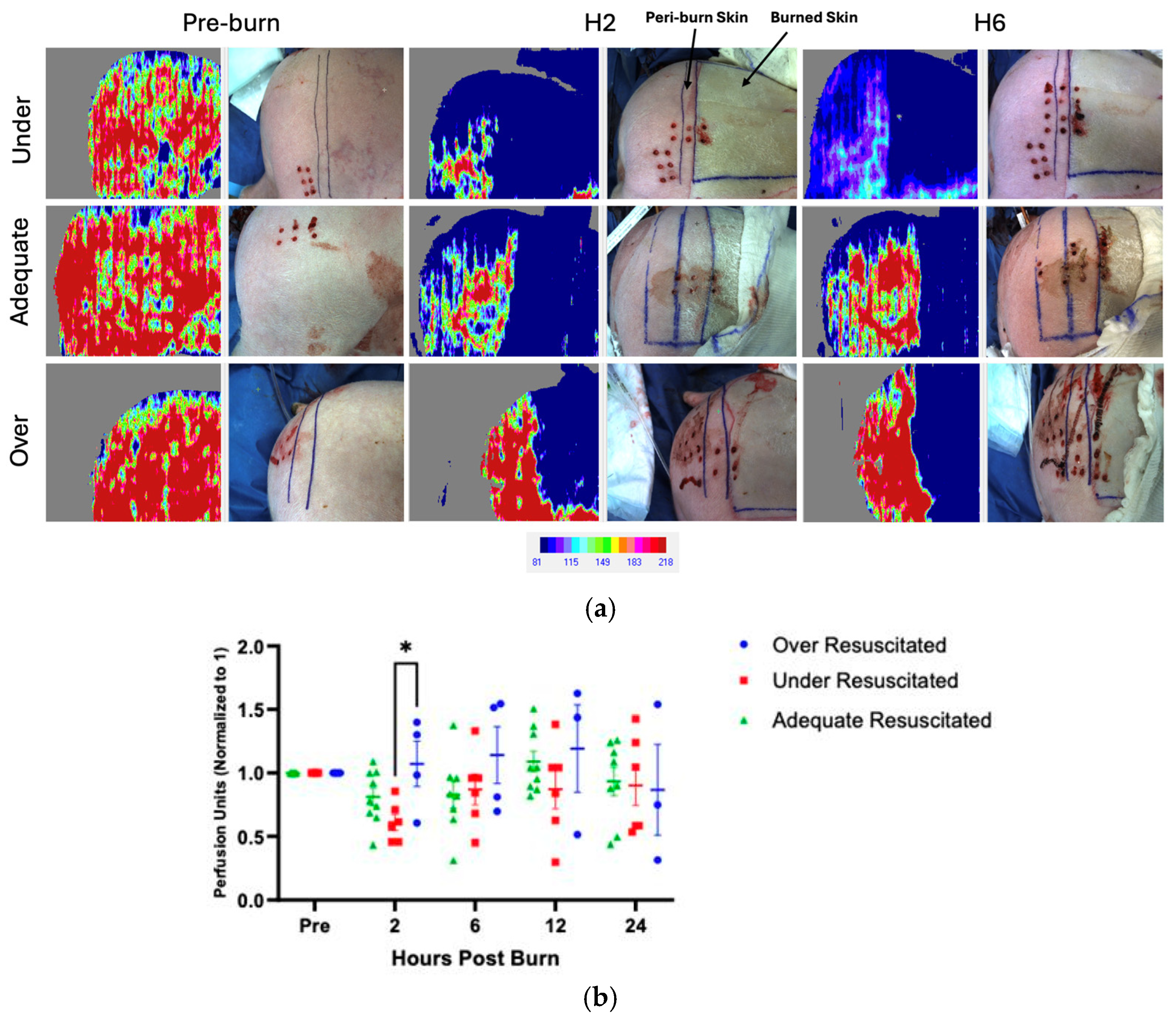

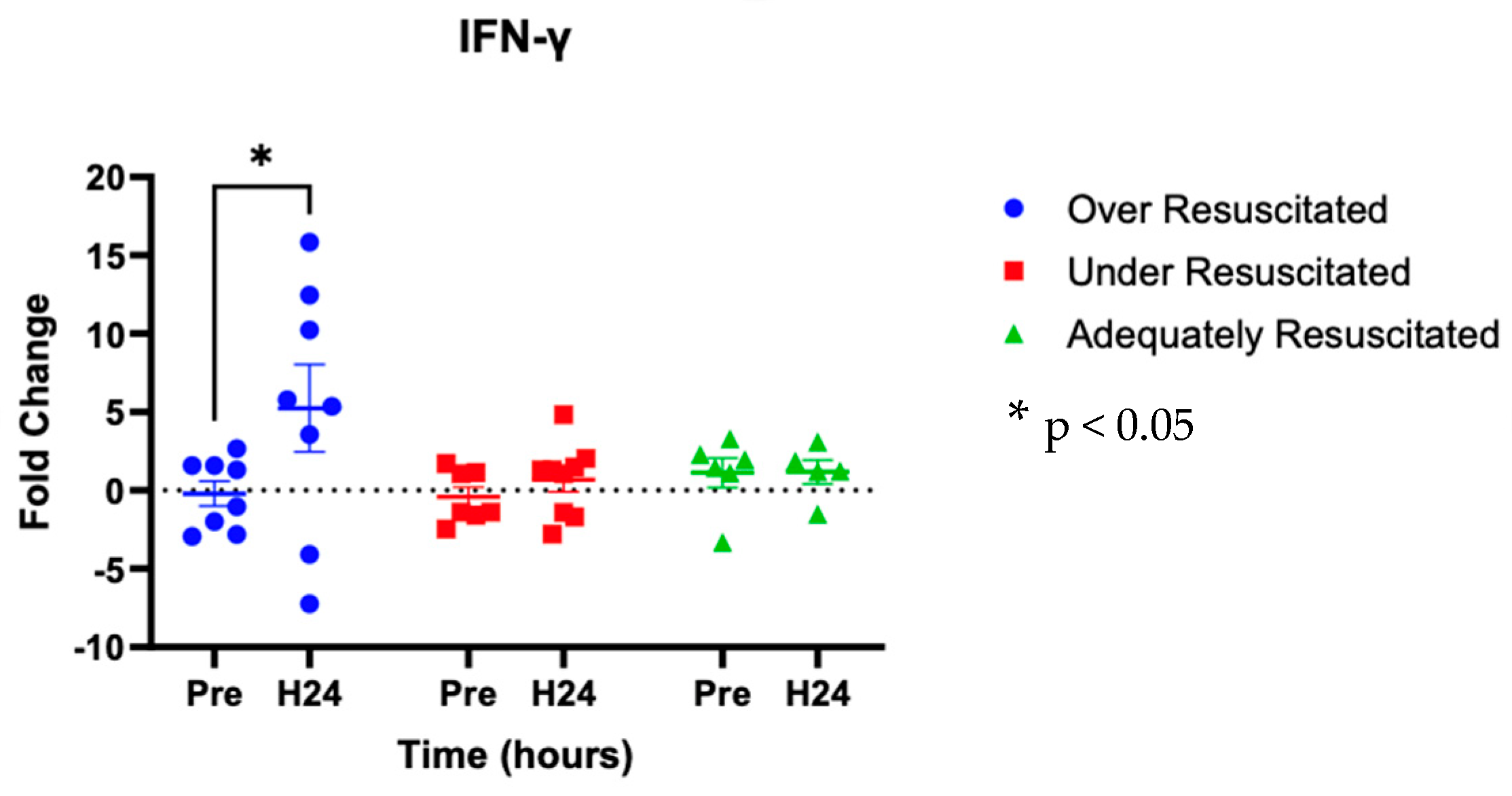

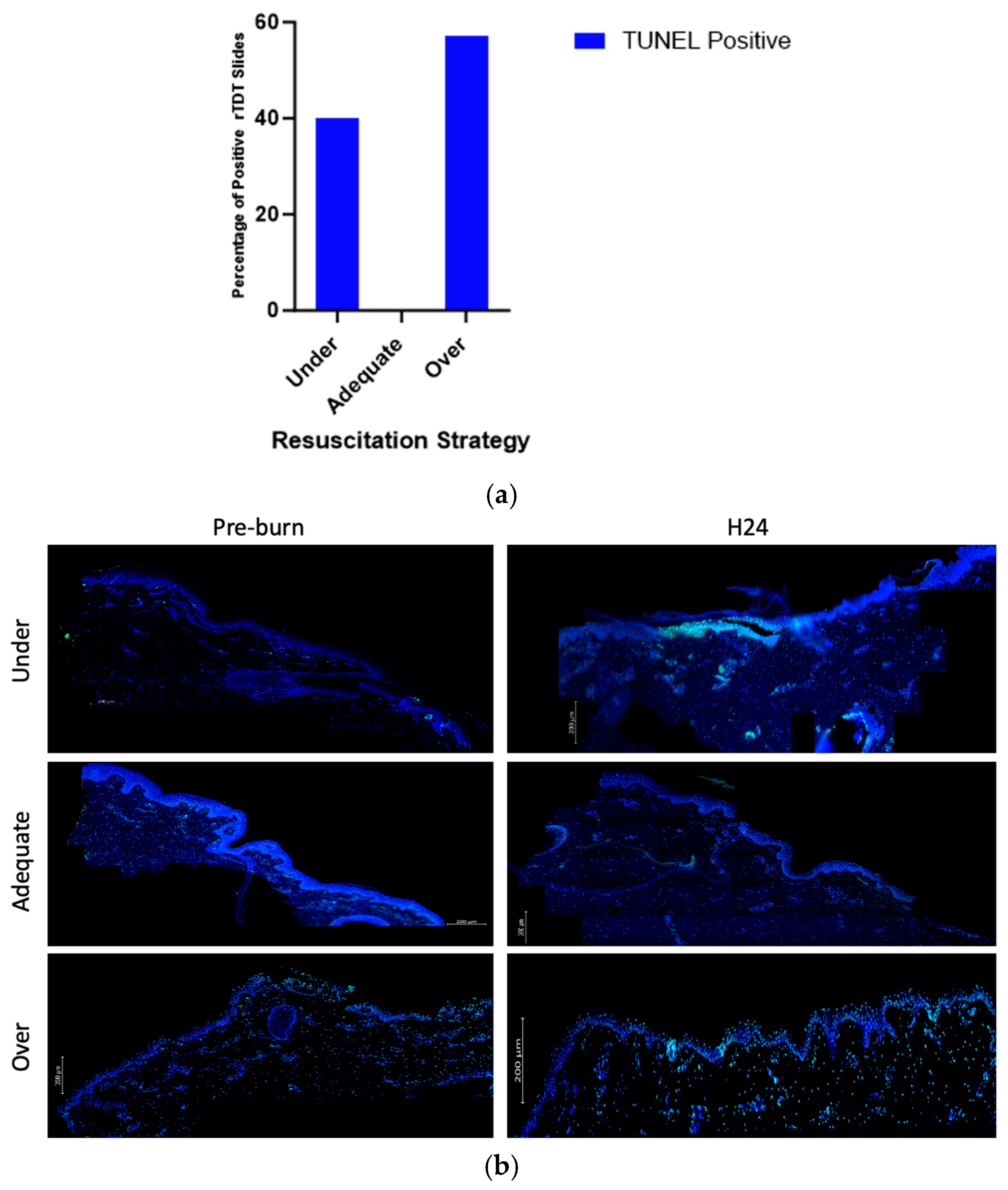
Disclaimer/Publisher’s Note: The statements, opinions and data contained in all publications are solely those of the individual author(s) and contributor(s) and not of MDPI and/or the editor(s). MDPI and/or the editor(s) disclaim responsibility for any injury to people or property resulting from any ideas, methods, instructions or products referred to in the content. |
© 2025 by the authors. Published by MDPI on behalf of the European Burns Association. Licensee MDPI, Basel, Switzerland. This article is an open access article distributed under the terms and conditions of the Creative Commons Attribution (CC BY) license (https://creativecommons.org/licenses/by/4.0/).
Share and Cite
Hage, T.R.; Kelly, E.J.; Ziedins, E.; Parajuli, B.; D’Orio, C.S.; Burmeister, D.M.; Moffatt, L.; Shupp, J.W.; Carney, B.C. Pilot Study on Resuscitation Volume’s Effect on Perfusion and Inflammatory Cytokine Expression in Peri-Burn Skin: Implications for Burn Conversion. Eur. Burn J. 2025, 6, 42. https://doi.org/10.3390/ebj6030042
Hage TR, Kelly EJ, Ziedins E, Parajuli B, D’Orio CS, Burmeister DM, Moffatt L, Shupp JW, Carney BC. Pilot Study on Resuscitation Volume’s Effect on Perfusion and Inflammatory Cytokine Expression in Peri-Burn Skin: Implications for Burn Conversion. European Burn Journal. 2025; 6(3):42. https://doi.org/10.3390/ebj6030042
Chicago/Turabian StyleHage, Tamer R., Edward J. Kelly, Eriks Ziedins, Babita Parajuli, Cameron S. D’Orio, David M. Burmeister, Lauren Moffatt, Jeffrey W. Shupp, and Bonnie C. Carney. 2025. "Pilot Study on Resuscitation Volume’s Effect on Perfusion and Inflammatory Cytokine Expression in Peri-Burn Skin: Implications for Burn Conversion" European Burn Journal 6, no. 3: 42. https://doi.org/10.3390/ebj6030042
APA StyleHage, T. R., Kelly, E. J., Ziedins, E., Parajuli, B., D’Orio, C. S., Burmeister, D. M., Moffatt, L., Shupp, J. W., & Carney, B. C. (2025). Pilot Study on Resuscitation Volume’s Effect on Perfusion and Inflammatory Cytokine Expression in Peri-Burn Skin: Implications for Burn Conversion. European Burn Journal, 6(3), 42. https://doi.org/10.3390/ebj6030042






